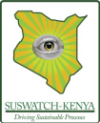World Bank- Sustainable Land Management - 2014
DEVELOPMENT PARTNER: WORLD BANK/ TERR AFRICA
Engagement of Non-State Actors in Sustainable Land Management through World Bank/TerrAfrica Initiatives:
Sub-Saharan Africa (SSA), and in particular Kenya is vulnerable to threats of natural resource degradation and poverty. This is due to various factors including a high population growth rate and increasing population pressure, reliance on agriculture that is vulnerable to environmental change, fragile natural resources and ecosystems, high rates of erosion and land degradation, and both low yields and high post-harvest yield losses.
Sustainable Land Management (SLM) is a strategic component of sustainable development and poverty alleviation. It therefore seeks to harmonize the often conflicting objectives of intensified economic and social development and enhancing the ecological and global life support functions of land resources. In Kenya, key policy and strategy documents, such as the Vision 2030 and the Agricultural Sector Development Strategy (ASDS), recognize and prioritize integrated and sustainable natural resource management. However barriers such as weak and conflicting policies, inadequate knowledge and skills and the fragmentation of SLM initiatives into various projects across different agencies and donors have led to a limited scale of intervention.
Fig. Ideal situation in SLM practices in Sub-Saharan Africa
It is on this basis that, Sustainable Environment Development Watch (SusWatch Kenya) with support from the World Bank had been organizing stakeholders’ consultative workshop in Sub-Saharan African countries through TerrAfrica initiative with a view to dialogue on best strategy to upscale SLM in the region.
TerrAfrica (TA) is a partnership between Sub-Saharan countries, donor countries and agencies, civil society and the research community with the collective goal of scaling up harmonized support for efficient and effective country driven sustainable land management. Through multi-stakeholder partnerships, TerrAfrica strategically addresses the knowledge and technology, policy, institutional and financial barriers and bottlenecks to the adoption and scaling up of many local level African driven land management approaches within the integrity of the landscape. TerrAfrica role is to promote programme based approaches to SLM implementation at country level. The aims of the initiative are to provide support for;
Coalition building amongst key stakeholders, improving the development, management and dissemination of SLM knowledge;
Leveraging and harmonizing the investment funds required for the promotion of SLM at local, national and sub-regional levels within Country determined SLM Investment Programmes, (CSIF).
TerrAfrica delivers its aims and principles by supporting partnerships among international, regional, district and local/community level stakeholders, with the long-term goal of restoring, sustaining and enhancing the productive and protective function of SSA land resources by combating the interrelated problems of land degradation, food insecurity and rural poverty.
The participation of civil society and local communities is thus fundamental to the wide scale adoption of SLM in Sub-Saharan Africa. Communities at the grassroots have SLM innovations that can contribute extensively to addressing land degradation and poverty reduction. These experiences deserve to be shared, up-scaled and integrated into national and international policy processes. Article Five of the UNCCD for instance, calls for affected country parties to “facilitate the participation of local populations, particularly women and youth, with the support of non-governmental organizations (“NGOs”), in efforts to combat desertification and mitigate the effects of drought”. Although many attempts have been made, the agencies involved in the implementation of the UNCCD have yet to align their operational processes in such a way that real participation of the Civil Society, including local non-governmental organizations, is ensured as anticipated by the Convention. This shortcoming is also true in the context of TerrAfrica.



